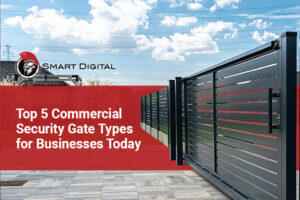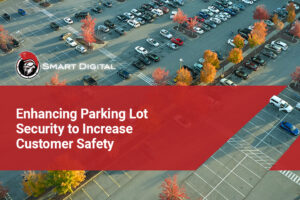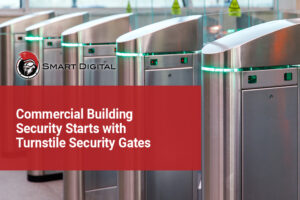Businesses are shifting away from traditional keys in favor of advanced locking systems that provide better control, monitoring, and convenience. Among the most common technologies available today are smart locks and electronic locks. Although these terms are often used interchangeably, the two systems differ in features, capabilities, and use cases, especially in commercial settings where security demands are high.
How Smart Locks Work
Smart locks are Wi-Fi, Bluetooth, or Z-Wave-enabled devices that allow users to lock or unlock doors remotely using a mobile app, web dashboard, or automation system. They often integrate with cloud-based platforms and can communicate with other devices, including security cameras, access gates, and alarm systems.
Typical features of smart locks include:
- Remote access through smartphones or desktops.
- Real-time activity logs and entry history.
- Integration with smart business security platforms.
- Temporary access codes for contractors or guests.
- Two-factor authentication or biometric input.
Smart locks offer a higher level of access control compared to traditional locking mechanisms, particularly for businesses seeking cloud-connected security solutions for commercial buildings. Their ability to integrate with broader systems makes them a strong choice for modern facilities, and smart locks and access control systems combine for better buildings.
Understanding Electronic Locks
Electronic locks are digital alternatives to mechanical key-based systems. These locks typically require a keycard, PIN, FOB, or RFID tag to grant access. Unlike smart locks, most electronic locks do not connect to the internet and cannot be controlled remotely unless integrated into a larger access control system.
Standard electronic locks include:
- Keypad locks with passcodes.
- Card readers using magnetic stripe or RFID.
- FOB-based entry systems.
- Standalone battery-powered units.
These locks provide a middle ground between mechanical keys and fully automated systems. They are often deployed in environments where network connectivity is limited, but there is still a need for non-key access control using RFID or keypads.
Comparing Smart Locks and Electronic Locks
| Feature | Smart Locks | Electronic Locks |
| Connectivity | Wi-Fi, Bluetooth, Z-Wave | Standalone or wired to access systems |
| Remote Control | Yes | Not by default |
| Access Methods | Mobile app, cloud dashboard, biometrics | PIN, RFID, FOB, keycard |
| Integration | Smart security systems, cloud platforms | Basic or limited integration |
| Audit Logs | Real-time event tracking | Manual or software-based, if supported |
| Maintenance | Software updates, battery monitoring | Battery changes, keypad upkeep |
Where Smart Locks Are a Better Fit
Smart locks are ideal for commercial facilities that require high levels of oversight, real-time control, and integration with broader surveillance and alarm systems. They are most commonly installed in:
- Corporate offices with remote employees.
- Logistics facilities with multiple access points.
- Schools or healthcare institutions that require lockdown protocols.
- Retail chains that need centralized access control.
The ability to assign time-sensitive access codes or revoke entry remotely makes them a valuable solution for managing multiple users or third-party service providers. Their scalability also makes them a preferred option for businesses adopting enterprise-grade smart lock systems. According to market research, the global smart lock market continues to expand as more businesses recognize these benefits.
When Electronic Locks Make Sense
Electronic locks are a reliable choice for facilities that don’t require real-time access control or internet connectivity. Their simplicity, durability, and low cost make them popular in:
- Warehouses with minimal personnel.
- Remote industrial sites where connectivity is limited.
- Budget-conscious projects.
- Supplemental doors that are not tied into the main security system.
They serve well in environments where full smart integration is unnecessary. In these cases, businesses value cost-effective locking solutions that offer audit trails without needing a full network connection.
Keyless Entry Systems and Business Efficiency
Whether smart or electronic, keyless entry systems provide several operational advantages over traditional locks:
- Reduced risk of lost or copied keys.
- Faster turnover during employee offboarding.
- Fewer manual lock changes or rekeying.
- Improved compliance with audit requirements.
For businesses managing high foot traffic or frequent visitor access, the convenience of mobile unlocks or code-based entries can reduce administrative workload. It also ensures higher security compliance by maintaining accurate entry logs. These are some of the reasons why keyless entry solutions are gaining traction in commercial settings, with keyless entry systems projected to cross $201.8 billion in total revenue by 2030.
Choosing Between Smart and Electronic Locks
The best choice depends on your business’s infrastructure, access needs, and available budget. Consider the following when making a decision:
- Infrastructure readiness: Do you have the internet connectivity or IT resources to support smart devices?
- Security needs: Do you need real-time alerts, remote control, or centralized management?
- Budget: Are you looking for a scalable solution or just replacing individual locks?
- Integration plans: Will the lock be part of a larger smart business security setup?
In many cases, a hybrid model is the best approach. Businesses often pair electronic locks on secondary doors with smart locks on main entries and sensitive areas. This allows for layered security while keeping costs manageable. When planning long-term security strategies, some companies are prioritizing advanced technology in commercial security that streamlines building security. Industry experts note that the rise of smart locks and smart access control represents a significant shift in how businesses approach security infrastructure.
Protect Your Business with Smart Digital® Solutions
Smart Digital® provides advanced business security systems that are trusted across Northern Ohio. We specialize in designing and installing fully integrated access control and surveillance technologies that help businesses operate safer, smarter, and more efficiently.
Our team delivers tailored solutions for commercial facilities of all types, including:
- RFID-enabled access gates and secure entry points.
- Smart locks that are connected to your surveillance and alarm systems.
- Keyless entry systems for multi-user environments.
- Real-time video monitoring and audit trail support.
- Certified installations backed by UL-trained technicians.
As a service-disabled Veteran-owned small business, we take pride in helping Ohio companies strengthen their security posture with affordable, expert-built systems.
Ready to take the next step? Contact Smart Digital® today to request a free quote and discover how we can secure your business with powerful, reliable solutions built for the real world.










